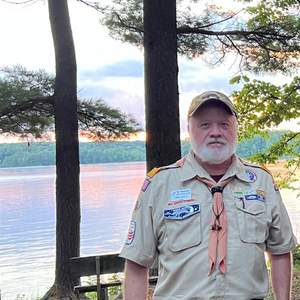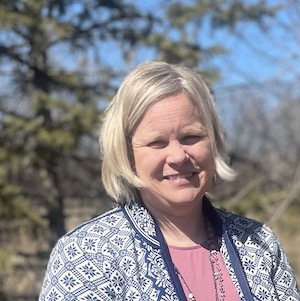Jim O'Brien
For Jim O’Brien, hockey is life. Growing up in Maplewood, MN, he looked forward to November when the cold weather would set in. His dad would flood the family’s backyard, transforming it into a giant ice rink, and little 4-year-old Jim would skate around with his siblings, slapping pucks into goals. What was a game played for fun as a kid turned into a serious sport for O’Brien. He was destined to play professional hockey, and sure enough, he was drafted to the National Hockey League (NHL) at the age of 18. It was an incredible opportunity. However, O’Brien’s choice to play meant that he would have to put another opportunity on hold—his college education.
Nearly a decade after making that pivotal decision with no regrets, O’Brien started to think about the degree he never completed. He knew professional hockey wasn’t a long-term career, while a degree would unlock opportunities for him off the ice. He explored options at the U of M and discovered the Multidisciplinary Studies (MdS) program, which fit his needs well and allowed him the flexibility to continue playing hockey while simultaneously chipping away at his degree.
“The flexibility of the MdS degree really made it possible for me to go back to school. It’ll be nice to have that degree when I’m done playing hockey,” O’Brien says.
A Strong Skater Goes Pro
When O’Brien was just 17 he played a season of hockey for the U of M’s Golden Gophers hockey team. This was a feat in itself because he needed a special exception to play university hockey, and he was the youngest player in US college ice hockey at the time. But O’Brien didn’t stay long. In 2007 he was drafted to play major junior hockey for two years, the formal path to his debut in the NHL. A professional career in hockey was something O’Brien definitely wanted; he just didn’t expect it to happen so soon.
“The team that drafted me really wanted me to go pro, and they held the keys to my future” O’Brien says. “I figured if they were willing to commit to a contract with me, that was something I should jump on. I didn’t expect it to happen; that’s just the way it worked out.”
His career in hockey took him all over the world. Most of the time, O’Brien played for the Ottawa Senators in Canada, but he also had contracts with other teams over the years. One of the most memorable was his contract abroad, playing with the Russian Kontinental Hockey League (KHL). For a year he lived in Novokuznetsk, a place O’Brien says was pretty much Siberia, a full four-hour flight east of Moscow. As an “import player,” O’Brien was one of only a handful of non-Russians, and he faced an extreme language barrier. Still, he excelled on the ice, where ability matters more than language.
“For the most part of my career I’ve been in Canada,” O’Brien says. “I’ve also played in Hershey, PA; Albany, NY; San Antonio, TX; and New Jersey. I’ve been all over the map.”
While traveling widely was an incredible experience for him, time was passing and O’Brien was getting older, which meant the clock was ticking on how much longer he could play hockey before his body couldn’t handle it anymore. Most professionals retire from the sport in their thirties, some in their twenties.
“As I got older, I started to think about what I’d do when I can’t play hockey anymore,” O’Brien says. “I know I can’t play forever, and I want to have something else I fall back on when my hockey days are over.”
A Degree to Fit an Unconventional Life
During one of O’Brien’s off-season summers back home in Minnesota, he took action on his urge to reignite his education. Back in his old stomping grounds at the U of M, he began to search through the University’s myriad offerings, and it was then that he discovered the MdS program. The degree promised an individualized approach for students wanting to design a degree to fit their needs and busy lives, as well as the attention of an advisor who would ensure students checked all the requirements they’d need to graduate. Best of all for O’Brien, the MdS program offered tremendous flexibility. He could take classes at a pace that worked for him, and he could even do the majority of those courses online.
“The program works out perfectly. It’s very flexible, so you can make it work with whatever job or obligations you have. And for me, that flexibility was huge.”
“I enrolled in the program and met with my advisor to come up with a plan,” O’Brien says. “I’m taking mostly business and communications classes, and that will eventually satisfy my degree requirements. It’ll be nice to have a broad set of skills. I know that there’s so much I’ll be able to do with a business and communications background one day.”
During the fall and spring semesters when he’s on the ice full-time, O’Brien does online coursework at a rate of one class per semester. When he’s home over the summer, he takes classes in-person. In this way, he’s making progress toward completing the degree that will prepare him for a life after hockey.
“The program works out perfectly,” O’Brien says. “It’s very flexible, so you can make it work with whatever job or obligations you have. And for me, that flexibility was huge. It’ll still be a couple of years until I graduate, but I’m getting there, slow and steady.”
His commencement date will happen soon enough, and at that point the question will be, what’s next? How does O’Brien envision life beyond hockey? He says, “It’s going to be a lot different, that’s for sure. Not playing will be an adjustment, but I guess everyone has those adjustments in life.”










